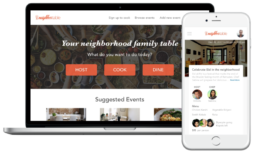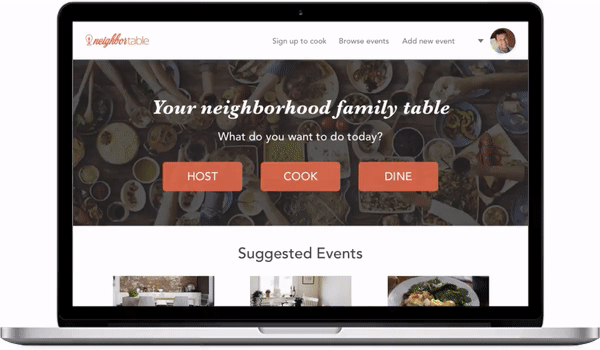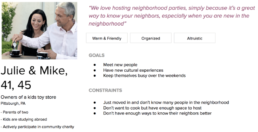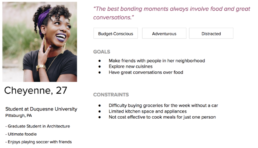Connecting neighborhoods through shared dining experiences
Project Overview
How might we create a way through which neighbors can cook and dine together without taking on the roles they don’t want to perform?
NeighborTable is a peer-to-peer economy platform that connects hosts that love to have folks in their homes, chefs that enjoy cooking for others, and diners that love unique and creative dining experiences in a close neighborhood.
Team members: Viba Subramaniam and Ross Rybalov
Role: I took lead on wireframing and visual design. I was involved throughout the entire design process including initial brainstorming, guerrilla research, ideation, personas designing, and scenarios modeling.
Domain: Peer-economy, Service Design, UI/UX
Tools: Sketch, Principle
Duration: 3 weeks
HI-FIDELITY PROTOTYPE
Desktop view
Given the time frame of 3 weeks, we did not design all the screens. This desktop view shows some of the screens in the host view and the diner view.
Mobile view
We imagine our platform to be a responsive website. This mobile view shows some of the screens in the chef view and the diner view.
DESIGN PROMPT
To design a peer-to-peer economy platform which connects people in a neighborhood.
DOMAIN SELECTION
In a team of three, we brainstormed a list of use cases and social contexts for our peer economy service for neighborhoods. After sharing personal experiences which helped us connect with other people in our own neighborhoods, we decided to explore the domain of neighborhood block parties.
GUERRILLA RESEARCH
To learn more about people’s experiences attending neighborhood block parties, we conducted interviews with 10 people. We did not select a particular demographics for selecting our participants and relied on quick access to individuals we could interview. We gathered insights from fellow students, faculty at our college and families in our neighborhoods.
Insights
- There is a lot of overhead in planning neighborhood parties like getting permits and taking care of all other logistics
- Three people shared their good experiences attending dinner parties organized by hosts at AirDine, Feastly, and EatWith. These are the apps which connect diners with chefs. They let users pay to eat at strangers’ houses who host the parties
- People want a way through which they can perform the tasks they like in a neighborhood party environment without having to perform roles they don’t want
We researched the apps mentioned by people in our interviews and found out that the challenge for these apps is not finding hosts willing to invite strangers over. It’s finding guests willing to show up because of discomfort in going to someone else’s homes.
We identified an opportunity to design such a model for neighborhoods where people are more likely to feel comfortable going to their neighbor’s houses to socialize and know each other.
PROJECT GOAL
How might we create a way through which neighbors can cook and dine together without taking on the roles they don’t want to perform?
OUR SOLUTION
We connect gracious hosts, skilled chefs, and adventurous foodies to create unforgettable meal experiences.
PERSONAS & SCENARIOS
After refining our problem statement, we created personas and generated scenarios to describe the context in which our service will be used and the value that will be exchanged.
GRACIOUS HOST
SCENARIO
Julie and Mike just moved to a new neighborhood in Pittsburgh. They had many friends where they lived previously but in the new place, they hardly know anyone. They decide to host a party over the weekend and invite their neighbors. But how would they invite anyone when they know no one.
They call up their friends to know if they know a way they can invite their neighbors for the party. Julie’s friend tells her about NeighborTable where she can sign herself up and host an event in her neighborhood. Julie signs up onto NeighborTable. She creates an event and is delighted to see that she can even find chefs in her neighborhood to cook for the event. She is glad that by connecting to the chef, she would already know someone in the neighborhood.
SKILLED CHEF
SCENARIO
Dan is an avid cook. Whenever he gets a free evening or some time during the weekend, he hones his Japanese knives, fires up his All-Clad cookware, and does his favorite hobby: whipping up a tasty meal. Dan’s friends just got him an amazing new Mediterranean cookbook full of amazing and challenging recipes and he really wants to try something from it, but he doesn’t want to buy specialized ingredients and cook just for himself.
Dan opens up NeighborTable and finds that Julie & Mike want to host a dinner this weekend and are looking for a chef, and their space matches what he needs. Dan signs up for the experience, J&M accept, they work out the details over the site.
On Saturday, Dan prepares a lovely meal in J&M’s home, guests sit down to eat together, and proceed to share stories about their lives.
ADVENTUROUS FOODIE
SCENARIO
Cheyenne is feeling hungry but doesn’t have a lot of options of things to cook at home. She’s also tired of eating out and wants a healthier home-cooked meal.
She checks her phone to see how long it would take to get to Trader Joe’s by bus. “25 minutes just to get there?” she grumbles to herself. She comes up with a new plan.
Cheyenne logs on to NeighborTable to see if anyone is hosting a meal she can join. She looks through a list of events in her neighborhood and finds one that catches her eye. She requests to join a lunch gathering of Puerto Rican food. 45 minutes later, she’s enjoying a steaming plate of Mofongo and chatting with new people in the neighborhood.
SITE MAP
We created the sitemap to help us define a systematic view of our peer economy website. We used this sitemap to design wireframes for the website. The rectangles marked with colored circles are the pages for whom we designed the wireframes and finally hi-fi mockups for desktop and mobile.
WIREFRAMES
HI-FIDELITY MOCKUPS
SERVICE VALUE
- Fostering connections between neighbors
- Enabling new cultural experiences
- Hobbyist chefs can use the platform to get the buzz going around them and use it to open their own restaurants
- If the cook is a chef at a restaurant, he/she can use this platform to
try out new cuisines, recipes, and techniques helping them refine their restaurant in a low-risk environment - Large businesses may find our data about the location of the events useful in opening analogous restaurants in areas with high activity









